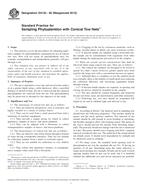Potrebujeme váš súhlas na využitie jednotlivých dát, aby sa vám okrem iného mohli ukazovať informácie týkajúce sa vašich záujmov. Súhlas udelíte kliknutím na tlačidlo „OK“.
ASTM D4132-82(2012)
Standard Practice for Sampling Phytoplankton with Conical Tow Nets (Withdrawn 2020)
Automaticky preložený názov:
Štandardné praktiky pre vzorkovanie Phytoplankton s kónickým Ťažná Nets
NORMA vydaná dňa 1.9.2012
Informácie o norme:
Označenie normy: ASTM D4132-82(2012)
Poznámka: NEPLATNÁ
Dátum vydania normy: 1.9.2012
Kód tovaru: NS-26169
Počet strán: 3
Približná hmotnosť: 9 g (0.02 libier)
Krajina: Americká technická norma
Kategória: Technické normy ASTM
Kategórie - podobné normy:
Anotácia textu normy ASTM D4132-82(2012) :
Keywords:
ICS Number Code 07.100.20 (Microbiology of water)
Doplňujúce informácie
| Significance and Use |
|
3.1 The advantages of conical tow nets are as follows: 3.1.1 They are relatively inexpensive, easy to construct, and highly versatile in a variety of surface waters. 3.1.2 They can be used from a small powered boat with a minimum of auxiliary equipment. 3.1.3 They provide a simple means by which to collect qualitative samples of macro- and micro-plankton. 3.1.4 They can be adapted with a flowmeter to collect semiquantitative samples of macro- and micro-plankton. 3.2 The disadvantages of conical tow nets are as follows: 3.2.1 They are effective only where drawn through a stratum of water having considerable thickness. They are not suitable for collecting samples from a small or restricted region. 3.2.2 They are not suitable for collections in very shallow water. 3.2.3 They collect only qualitative samples, or semiquantitative samples when used with a flowmeter. 3.2.4 Clogging of the net by extraneous materials, such as floating vascular plants or debris can cause erroneous results. 3.2.5 If discrete depths are sampled using a horizontal tow, the sample can be contaminated with organisms from other depths during the deployment and retrieval of the samples. 3.3 There are several special considerations that shall be observed when using conical tow nets. They are as follows: 3.3.1 The conical net samplers are designed to be towed at speeds less than 3 knots; however, greater speeds have been used for the larger nets with a concomitant increase in capture. 3.3.2 Although there is a tendency to use the smallest mesh size available, there is the liability of small mesh sizes reducing the collection efficiency and increasing equipment failure through tearing. 3.3.3 If discrete depth samples are required, an opening and closing net device should be installed on the sampler. 3.3.4 The nets should be washed frequently and inspected for pin-size holes, tears, net deterioration, and other anomalies. 3.3.5 Following use, wet nets should be suspended full length in air and in subdued light and allowed to dry. |
| 1. Scope |
|
1.1 This practice covers the procedures for obtaining qualitative samples of a phytoplankton community by use of conical tow nets. Nets will not retain all phytoplankton taxa; for example, nannoplankton and ultraplankton generally will pass through a net. 1.2 This standard does not purport to address all of the safety concerns, if any, associated with its use. It is the responsibility of the user of this standard to establish appropriate safety and health practices and determine the applicability of regulatory limitations prior to use. |
Podobné normy:
Historická
1.9.2010
Historická
1.12.2012
Historická
1.10.2011
Historická
1.12.2012
Historická
1.7.2012
Historická
1.6.2013



 ASTM E1706-05(2010)..
ASTM E1706-05(2010).. ASTM E1841-04(2012)..
ASTM E1841-04(2012).. ASTM E2783-11
ASTM E2783-11 ASTM E724-98(2012)..
ASTM E724-98(2012).. ASTM F1094-87(2012)..
ASTM F1094-87(2012).. ASTM F838-05(2013)..
ASTM F838-05(2013)..
 Cookies
Cookies
